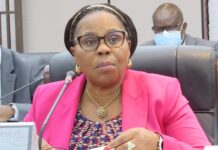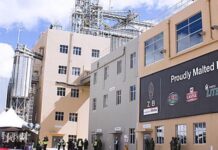Talkmore Gandiwa
HARARE – Invictus energy is set to drill the Mukuyu second well by end of August, which is set to target 22 cubic feet and 800 million of barrels condensate.
The drilling of the Mukuyu-1 exploration well will commence in August 2022, with high impact basin opening drilling campaign.
In an interview, Invictus chairman Stuart Lake said the company is more than ready to kick start the second well as all the equipment needed is now on the ground.
“We are beginning to drill the second well in the next three to four weeks…which is by end of August. All the equipment is now on the ground and we are excited about this development,” said Lake.
“The reason why we want to drill the second well is that we want to test the independent players. If it is successful it will unlock running room for the Mukuyu prospect,” ädded Lake.
The company have seven set targets to test and success if any one of those will be from the sort of volumes that the company is anticipating in one of the horizons. Lake said “We have selected these targets to test as many horizons as possible to give us maximum chance of success and unlock this basin. If the system does work, it doesn’t work in isolation…all those discovery trends you don’t just find one field in isolation you find a lot of them in the basement.”
Invictus Energy Managing Director Scott MacMillan, in an interview said the site was completed and handed over to the contractor and the drilling is set to commerce in August.
“The Mukuyu-1 well pad has been completed and handed over. The full rig arrival had been held up due to customs clearance delays in both Tanzania and Mozambique en-route to Zimbabwe, with drilling now expected to commence in August.”
Macmillan added that another 150 plus loads will arrive in the country over the coming week, carrying more rig equipment’s and other materials ahead of the drilling.
Invictus Energy says that the Muzarabani exploration is the largest undrilled conventional oil gas prospect onshore in Africa which contains an estimated 283.2 billion cubic metres of gas and almost 250-million barrels of oil.
Meanwhile, Invictus is taking steps to address carbon emissions from future oil and gas production at its Cabora Bassa gas project following the award of three carbon offset projects.
The company was awarded 30-year contracts from the Forestry Commission of Zimbabwe (FCZ) for the development of the Ngamo-Gwayi-Sikumi (NGS) Reducing Emissions from Deforestation and forest Degradation (REDD+) projects, which cover a combined 301,565ha of indigenous forest in the Matabeleland North province.
Invictus Energy (ASX:IVZ) expects the projects, which can be renewed for a further 30 years, to offset all Scope 1 and 2 emissions from Cabora Bassa production with excess markets to be sold on the Voluntary Carbon Market.
Cabora Bassa is expected to have less than 15 million tonnes of CO2 emissions across its entire project lifecycle based on the hypothetical 8 trillion cubic feet natural gas development.
With the REDD+ projects estimated to generate more than 30 million carbon credits over their initial 30-year life, the company expects Cabora Bassa to be the first cradle to grave carbon neutral oil and gas project.
As part of the move, it has created a new division – Miombo Forest Carbon Investments (MFCI) – to develop and manage the NGS REDD+ project and the carbon credits generated, which will be certified through Verra’s internationally recognised Verified Carbon Standard (VCS) program.
Accreditation of the project and registration and issuance of the carbon credits is expected to take about 12 months to complete.
“The award of these carbon offset projects marks a significant milestone for Invictus and will make Cabora Bassa one of the first carbon neutral oil and gas projects from the exploration phase to decommissioning, if our upcoming drilling campaign is a success,” said Macmillan.
He noted that the company had actively sought a carbon management solution that would benefit the country and communities where it operated and that the NGS REDD+ project would offset its emissions while preserving Zimbabwe’s rich biodiversity and creating jobs with sustainable incomes for the entire region.
“Additional revenue generated from carbon credits will also aid the work Invictus is doing to improve health and education in the local communities where we operate, well beyond the initial 30-year term of the initial NGS REDD+ project,” Macmillan added.
The Makuyu-1 exploration well is expected to spud this month, targeting an estimated 20 trillion cubic feet and 845 million barrels of conventional gas condensate.
REDD+ was created by the United Nations under its Framework Convention on Climate Change, or UNFCCC, to reduce carbon emissions from deforestation and forest degradation whilst supporting local communities through socio-economic projects in line with principles on sustainable management, forest protection and nature conservation.
The concept was proven by a five-year pilot, administered and funded by the Global Environmental Facility through the World Bank as part of the Hwange Sanyathi Biodiversity Corridor, in the Ngamo and Sikumi forests in early 2020.
Invictus and the FCZ will develop the NGS REDD+ project to protect the indigenous forests by implementing programs to mitigate deforestation activities.
Certification of carbon credits will be achieved through Verra’s VCS program – a vigorous international standard which seeks to verify emissions reductions generated by carbon reduction projects, such as REDD+, are real, measurable, additional and permanent.
It allows third party-validated projects to generate Verified Carbon Units (VCUs) by implementing activities that reduce deforestation against a defined baseline.VCUs can in turn be sold on the Voluntary Carbon Market, which gives companies, non-profit organisations, governments, and individuals the opportunity to buy and sell carbon offset credits.
The estimated volume of carbon credits required globally is projected to increase at least 20- fold by 2035, with volumes increasing 30 to 40-fold from current levels in scenarios consistent with the Paris Agreement on climate change by 2050.
This is expected to result in a strong pricing outlook, but is dependent on carbon credit quality and attributes as well as the types of co-benefits generated by the project.

















